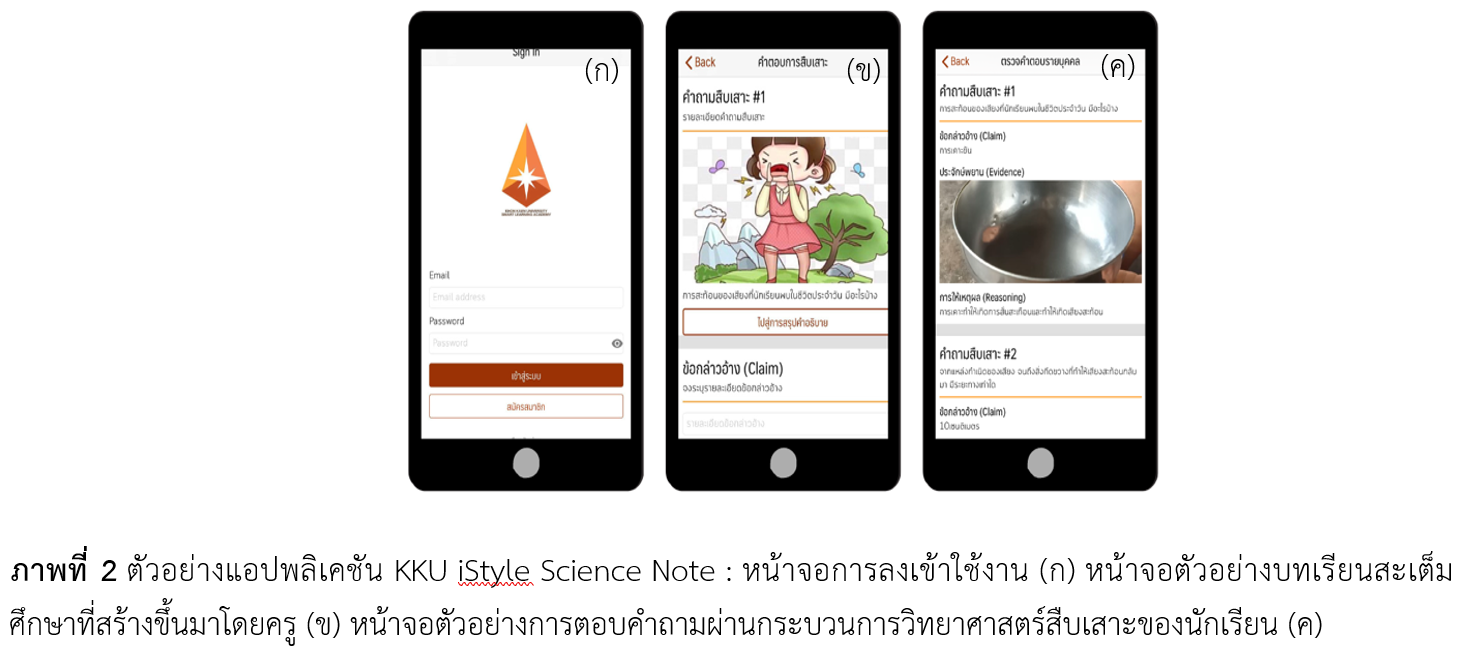การพัฒนาสมรรถนะการอธิบายอย่างเป็นวิทยาศาสตร์และแรงจูงใจทางวิทยาศาสตร์ของนักเรียนระดับชั้นมัธยมศึกษาตอนปลายผ่านกลวิธีการจัดการเรียนรู้สะเต็มศึกษาแบบไร้รอยต่อ
Main Article Content
บทคัดย่อ
สมรรถนะการอธิบายอย่างเป็นวิทยาศาสตร์และแรงจูงใจทางวิทยาศาสตร์ถูกยอมรับว่าเป็นผลลัพธ์ของการเรียนรู้ที่สำคัญของการจัดการศึกษาวิทยาศาสตร์ระดับโรงเรียนอันจะนำผู้เรียนไปสู่การประสบผลสำเร็จในการรู้วิทยาศาสตร์ได้ งานวิจัยนี้เป็นการศึกษาความก้าวหน้าของสมรรถนะการอธิบายอย่างเป็นวิทยาศาสตร์และแรงจูงใจทางวิทยาศาสตร์ของนักเรียนชั้นมัธยมศึกษาตอนปลายที่ได้รับการจัดการเรียนรู้โดยใช้กลวิธีการจัดการเรียนรู้สะเต็มแบบไร้รอยต่อในบริบทที่เป็นการผสานร่วมระหว่างการเรียนรู้แบบเป็นทางการ (ในชั้นเรียน) และไม่เป็นทางการ (นอกชั้นเรียน) ผู้วิจัยออกแบบและพัฒนากลวิธีการจัดการเรียนรู้สะเต็มแบบไร้รอยต่อดังกล่าวและทดลองใช้ในการจัดการเรียนรู้กับนักเรียนระดับชั้นมัธยมศึกษาตอนปลาย จำนวน 23 คน เป็นระยะเวลา 400 นาที โดยเก็บรวบรวมข้อมูลทั้งก่อนและหลังการเรียนรู้ด้วยกลวิธีดังกล่าวของนักเรียนโดยใช้แบบวัดวัดการสร้างคำอธิบายวิทยาศาสตร์แบบอัตนัย และแบบสอบถามวัดแรงจูงใจทางวิทยาศาสตร์แบบมาตราส่วนประมาณค่า 5 ระดับ วิเคราะห์ข้อมูลเปรียบเทียบคะแนนก่อนเรียนและหลังเรียนโดยการคำนวณหาค่าความก้าวหน้าทางการเรียนรู้แบบที่เป็น Normalized Gain ผลการวิจัยพบว่า นักเรียนมีความก้าวหน้าของสมรรถนะการอธิบายอย่างเป็นวิทยาศาสตร์ครบถ้วนทั้ง 3 องค์ประกอบย่อย ได้แก่ คำกล่าวอ้าง ประจักษ์พยาน และการให้เหตุผล และมีความก้าวหน้าในแรงจูงใจทางวิทยาศาสตร์ครบถ้วนทั้ง 5 ด้านย่อย ได้แก่ ความจูงใจภายใน การตัดสินใจด้วยตนเอง ประสิทธิภาพของตนเอง ความจูงใจในการทำงาน และความจูงใจในผลการเรียน หลังจากที่ได้รับประสบการณ์การเรียนรู้ในกลวิธีการจัดการเรียนรู้สะเต็มแบบไร้รอยต่อของการวิจัยในครั้งนี้ ดังนั้นจะเห็นได้ว่ากลวิธีการจัดการเรียนรู้สะเต็มแบบไร้รอยต่อนี้มีประสิทธิภาพที่สามารถสร้างความก้าวหน้าทางการเรียนรู้ในมิติผลลัพธ์การเรียนรู้ที่เป็นสมรรถนะการอธิบายอย่างเป็นวิทยาศาสตร์และแรงจูงใจทางวิทยาศาสตร์ได้เป็นอย่างดี ซึ่งกลวิธีการจัดการเรียนรู้ดังกล่าวสามารถที่จะเป็นอีกแนวทางใหม่ในการจัดการเรียนรู้วิทยาศาสตร์ในระดับโรงเรียนและเป็นบริบทของการจัดการเรียนรู้วิทยาศาสตร์กลวิธีใหม่สำหรับครูผู้สอนในระดับโรงเรียนได้
Article Details

อนุญาตภายใต้เงื่อนไข Creative Commons Attribution-NonCommercial-NoDerivatives 4.0 International License.
วารสารวิทยาศาสตร์และวิทยาศาสตร์ศึกษา (JSSE) เป็นผู้ถือลิสิทธิ์บทความทุกบทความที่เผยแพร่ใน JSSE นี้ ทั้งนี้ ผู้เขียนจะต้องส่งแบบโอนลิขสิทธิ์บทความฉบับที่มีรายมือชื่อของผู้เขียนหลักหรือผู้ที่ได้รับมอบอำนาจแทนผู้เขียนทุกนให้กับ JSSE ก่อนที่บทความจะมีการเผยแพร่ผ่านเว็บไซต์ของวารสาร
แบบโอนลิขสิทธิ์บทความ (Copyright Transfer Form)
ทางวารสาร JSSE ได้กำหนดให้มีการกรอกแบบโอนลิขสิทธิ์บทความให้ครบถ้วนและส่งมายังกองบรรณาธิการในข้อมูลเสริม (supplementary data) พร้อมกับนิพนธ์ต้นฉบับ (manuscript) ที่ส่งมาขอรับการตีพิมพ์ ทั้งนี้ ผู้เขียนหลัก (corresponding authors) หรือผู้รับมอบอำนาจ (ในฐานะตัวแทนของผู้เขียนทุกคน) สามารถดำเนินการโอนลิขสิทธิ์บทความแทนผู้เขียนทั้งหมดได้ ซึ่งสามารถอัพโหลดไฟล์บทความต้นฉบับ (Manuscript) และไฟล์แบบโอนลิขสิทธิ์บทความ (Copyright Transfer Form) ในเมนู “Upload Submission” ดังนี้
1. อัพโหลดไฟล์บทความต้นฉบับ (Manuscript) ในเมนูย่อย Article Component > Article Text
2. อัพโหลดไฟล์แบบโอนลิขสิทธิ์บทความ (Copyright Transfer Form) ในเมนูย่อย Article Component > Other
ดาวน์โหลด ไฟล์แบบโอนลิขสิทธิ์บทความ (Copyright Transfer Form)
เอกสารอ้างอิง
Asmiliyah, A., Khaerudin, K. and Solihatin, E. (2021). Mobile learning with STEM approach in physics learning. Journal of Education Research and Evaluation, 5(4), 606.
Berland, L. and Reiser, B. J. (2009). Making sense of argumentation and explanation. Science Education, 93(1), 26-55.
Beyer, C. J. and Davis, E. A. (2008). Fostering second graders’ scientific explanations: A beginning elementary teacher’s knowledge, beliefs, and practice. The Journal of the Learning Sciences, 17(3), 381-414.
Buck, L. B., Bretz, S. L., and Towns, M. H. (2008). Characterizing the level of inquiry in the undergraduate laboratory. Journal of College Science Teaching, 38, 52-58.
Chamrat, S. (2017). The definition of STEM and key features of STEM education learning activity (in Thai). STOU Education Journal, 10(2), 13-34.
Chan, T. W., Roschelle, J., His, S., Kinshuk, D., Sharples, M., Brown, T., Patton, C., Cherniavsky, J., Pea, R., Norris, C., Soloway, N., Balacheff, N., Scardamalia, M., Dillenbourg, P., Looi, C. k., Milrad, M. and Hoppe, U. (2006). One-to-one technology-enhanced learning: An opportunity for global research collaboration. Research and Practice in Technology-Enhanced Learning, 1(1), 3–29.
Fung, C. H., Poon, K. K. and Ng, S. P. (2022). Fostering student teachers’ 21st century skills by using flipped learning by teaching in STEM education. EURASIA Journal of Mathematics, Science and Technology Education, 18(12), em2204
Ginzburg, T. and Barak, M. (2023). Technology-enhanced learning and its association with motivation to learn science from a cross-cultural perspective. Journal of Science Education and Technology, 32, 597-606.
Glynn, S. M., Brickman, P., Armstrong, N. and Taasoobshirazi, G. (2011). Science motivation questionnaire II: Validation with science majors and nonscience Majors. Journal of Research in Science Teaching, 48(10), 1159-1176.
Hake, R. R. (1998). Interactive-engagement vs traditional methods: a six-thousand-student survey of mechanics test data for introductory physics courses. American Journal of Physics, 66, 64–74.
Kamtet, W., Kruea-In, N. and Wannagatesiri, T. (2020). Developing scientific explanation ability of biology student teachers by providing experiences in generating scientific evidences and writing scientific explanations. Journal of Education and Innovation, 25(1), 238–251.
Kelley, T. R., and Knowles, J. G. (2016). A conceptual framework for integrated STEM education. International Journal of STEM Education, 3, 11.
McNeill, K. L. and Krajcik, J. S. (2008). Inquiry and scientific explanations: Helping students use evidence and reasoning. In J. Luft, R. Bell & J. Gess-Newsome (Eds.). Science as inquiry in the secondary setting. (p. 121-134). Arlington, VA: National Science Teacher Association Press.
Phaprom, P. and Srisawasdi, N. (2018). Promoting students’ conceptual understanding and scientific and engineering practices for the students in Mattayomsuksa 6 with Inquiry-based STEM learning module on nanoscience (in Thai). Journal of Graduate Research, 9(2), 43–67.
Song, Y. (2014). Bring Your Own Device (BYOD)” for seamless science inquiry in a primary school. Computers & Education, 74, 50-60.
Song, Y. (2018). Improving primary students’ collaborative problem solving competency in project-based science learning with productive failure instructional design in a seamless learning environment. Educational Technology Research and Development, 66, 979–1008.
Soodjai, S. and Srisawasdi, N. (2021). Effect of Digital Card Game-based Open Inquiry Science Learning on Protein Synthesis on Secondary School Students’ Learning Motivation toward Biology (in Thai). Journal of Education Khon Kaen University, 44(4), 68-83.
Sritawan, N. and Srisawasdi, N. (2022). Effect of seamless STEM learning on Newton’s law of motion on scientific explanation competency (in Thai). Journal of Education (Graduate Studies Research) Khon Kaen University, 16(1), (32-54).
The Institute for the Promotion of Teaching Science and Technology (IPST). (2023). PISA 2022 Results: Executive Summary (in Thai). Bangkok: The Institute for the Promotion of Teaching Science and Technology Press.
Vedder-Weiss, D. and Fortus, D. (2012). Students’ declining motivation to learn science: A follow up study. Journal of Research in Science Teaching, 49(9), 1057-1095.
Wong, L. H. and Looi, C. K. (2011). What seams do we remove in mobile-assisted seamless learning? A critical review of the literature. Computers & Education, 57(4), 2364–2381.
Yodsanga, S. and Srisawasdi, N. (2021) The Effect of Using Digital Board Game-Based Learning Scientific Inquiry Approach. On Science Motivation Regarding Photosynthesis Phenomenon (in Thai). Journal of Education Khon Kaen University, 44(3), 144-162.


